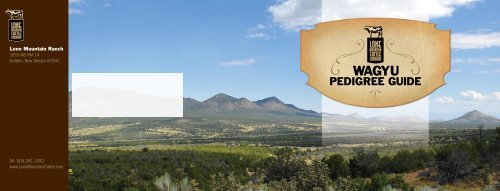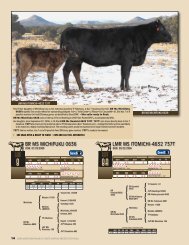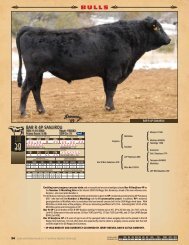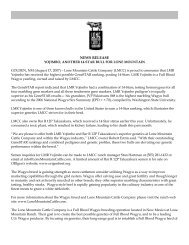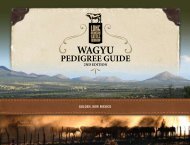PEDIGREE GUIDE - The Lone Mountain Cattle Company
PEDIGREE GUIDE - The Lone Mountain Cattle Company
PEDIGREE GUIDE - The Lone Mountain Cattle Company
Create successful ePaper yourself
Turn your PDF publications into a flip-book with our unique Google optimized e-Paper software.
<strong>Lone</strong> <strong>Mountain</strong> Ranch<br />
1818 AB NM 14<br />
Golden, New Mexico 87047<br />
1818 AB NM 14<br />
Golden, New Mexico 87047<br />
www.<strong>Lone</strong><strong>Mountain</strong><strong>Cattle</strong>.com<br />
505.281.1432 WAGYU<br />
<strong>PEDIGREE</strong> <strong>GUIDE</strong><br />
Tel: 505.281.1432<br />
www.<strong>Lone</strong><strong>Mountain</strong><strong>Cattle</strong>.com
Dear <strong>Cattle</strong> Producer,<br />
Introduction<br />
JVP Fukutsuru 068 .......................... page 4<br />
Michifuku ........................................ page 6<br />
Sanjirou .......................................... page 8<br />
Shigeshigetani .............................. page 10<br />
Yasufuku J930 ............................... page 11<br />
Yasufuku Jr. ................................... page 12<br />
Takazakura .................................... page 13<br />
Dai 7 Itozakura ............................. page 14<br />
Kitaguni 7-8 J1530 ....................... page 15<br />
Kitaguni Jr. .................................... page 16<br />
TF Itomichi 1-2 .............................. page 17<br />
Itozurudoi TF151 ........................... page 18<br />
Dai 20 Hirashige J287 .................. page 19<br />
Welcome to the world of Wagyu, a world too<br />
long shrouded in mystery and myth.<br />
This guide will help to make known the story of<br />
a fantastic breed of cattle. You’ll be introduced<br />
to the lineage of present-day Wagyu, allowing<br />
you to make breeding choices that will pay<br />
impressive dividends.<br />
<strong>The</strong> study of pedigree is important in any breed,<br />
but particularly so for Wagyu. By understanding<br />
the Wagyu breeding history, you will gain insight<br />
into how breeders have managed to bring the<br />
Wagyu herd to the pinnacle of meat quality today.<br />
We believe that this in-depth knowledge of<br />
Wagyu pedigrees will help to guide you in making<br />
valuable decisions affecting and refining the<br />
quality of your herd. <strong>The</strong> more you learn about<br />
this remarkable breed and move beyond mystery<br />
and myth, the more you will want to incorporate<br />
its superior genetics into your herd’s profile.<br />
<strong>The</strong> main sire lines exported from Japan in the<br />
1990s were Tajima (or Tajiri), Fujiyoshi (or<br />
Shimane) and Kedaka (or Tottori).<br />
Tajima sires are known for fine marbling<br />
and excellent beef quality, along with a<br />
smaller frame size, and a somewhat lower<br />
rate of growth. Tajima sires from the Hyogo<br />
Prefecture produce the only genuine Kobe<br />
Beef. Fukutsuru 068, Michifuku, Sanjirou,<br />
and Kitateruyasudoi J2810 (ETJ 003) are<br />
some of the elite marbling Tajima sires that<br />
provide the base of the <strong>Lone</strong> <strong>Mountain</strong><br />
Wagyu herd.<br />
Fujiyoshi sires produce well-balanced cattle<br />
that present larger frame size, good growth,<br />
and strong mothering abilities, though with<br />
somewhat coarser marbling. Dai 7 Itozakura<br />
J65 is the most famous sire in this line, and<br />
his descendants — TF Itomichi 1-2, Kitaguni<br />
Jr., and Itoshigefuji TF147, to name a few —<br />
are now used in the <strong>Lone</strong> <strong>Mountain</strong><br />
breeding program.<br />
Kedaka lines from the Tottori District descend<br />
from the sire Kedaka J7212. <strong>The</strong>y exhibit<br />
good growth and larger frames, and are<br />
known for their fine, loose skin. <strong>The</strong> most<br />
influential Kedaka sire is Dai 20 Hirashige<br />
J287, whose semen is still used in Japan,<br />
though it is extremely rare and very expensive.<br />
His son, Hirashigetayasu (ETJ 001) J2351, is<br />
being used at <strong>Lone</strong> <strong>Mountain</strong>; another son,<br />
Hirashigekatsu, is currently one of the most<br />
popular sires in Japan.<br />
<strong>The</strong> premier Japanese breeder, Shogo Takeda,<br />
describes the classic Japanese rotation<br />
breeding plan of mating a high-marbling<br />
female to a sire known for size or frame,<br />
and then back-crossing to a marbling sire as<br />
Modoshi Kohai, which produces a large<br />
animal of good marbling, milk production,<br />
and calf-raising potential.<br />
<strong>Lone</strong> <strong>Mountain</strong> wholeheartedly embraces this<br />
Wagyu breeding philosophy. We started our<br />
Full Blood Wagyu herd with selected Tajima<br />
bloodlines and are now out-crossing to both<br />
the Dai 7 Itozakura and Dai 20 Hirashige<br />
lines in order to add size and frame, with the<br />
intention of back-crossing those females to<br />
high-marbling sires.<br />
Hirashigetayasu (ETJ001) J2351 ... page 20<br />
Hirashigekatsu .............................. page 21<br />
Thank you for your interest.<br />
Kitateruyasudoi J2810................... page 22<br />
JVP Kikuyasu 400 ......................... page 23<br />
Bob Estrin<br />
<strong>Lone</strong> <strong>Mountain</strong> <strong>Cattle</strong> <strong>Company</strong><br />
www.<strong>Lone</strong><strong>Mountain</strong><strong>Cattle</strong>.com<br />
2<br />
3
<strong>Lone</strong> <strong>Mountain</strong> Ranch | WAGYU LINEAGE<br />
Yasumi Doi J10328<br />
FB548<br />
Tayasu Doi J7208<br />
Japanese Cow<br />
Dai 2 Yasutsuru 774<br />
FB306<br />
Kikutsuru J978542<br />
FB308<br />
Kikumidoi J5367<br />
FB511<br />
Syofuku 3<br />
JVP Fukutsuru 068<br />
JVP Fukutsuru 068 is perhaps the most<br />
famous Wagyu sire in U.S. history, and<br />
certainly the prime example of Tajima<br />
bloodlines. He leads all sires in marbling<br />
in the 2006 U.S. Wagyu Sire Summary<br />
(published by Washington State University),<br />
outpacing all other Wagyu sires by a broad<br />
margin. He also headed the previous Sire<br />
Summary, published in 2001.<br />
Japanese Venture Partners (JVP) imported<br />
Fukutsuru 068 into the United States in 1994.<br />
Fukutsuru 068 has a current marbling EPD<br />
of +.752, with the next highest bull assigned<br />
+.534. And his lineage is a star-studded<br />
affair: Fukutsuru 068’s sire is the offspring of<br />
Yasumi Doi J10328 and Kikutsuru J978542,<br />
two of the most famous Japanese Wagyu.<br />
(Kikutsuru J978542 was nicknamed the<br />
Hyogo Cow, Hyogo being the home prefecture<br />
of genuine Japanese Kobe Beef.) Fukutsuru<br />
068 traces twice to Kikutsuru J978542, who<br />
was born in 1967 and gave birth to 16 calves,<br />
seven of whom became famous.<br />
Fukutsuru 068 also traces twice to<br />
Yasumi Doi J10328, the sire of Yasutanidoi<br />
J472 and Monjiro 11550, and grandsire<br />
of Yasufuku 930.<br />
Yasumi Doi J10328 is considered to be one of<br />
the most prominent members of the Tajima/<br />
Tajiri line, cattle descended from Tajiri, a<br />
sire born in the Mikata District of Hyogo<br />
Prefecture. <strong>The</strong> Tajiri is an influential sire<br />
line to which almost all strains within Hyogo<br />
Prefecture are related. This lineage is known<br />
for good temperaments, demonstrated by its<br />
large number of influential sires. <strong>The</strong>y<br />
also express smaller frames and a lower<br />
growth rate.<br />
With these bloodlines and lineage, it is no<br />
wonder that Fukutsuru 068 has been proven<br />
by Washington State University as the number<br />
one marbling bull in the Sire Summary.<br />
JVP Fukutsuru 068<br />
FB2101<br />
Teruyasu J649663<br />
FB307<br />
Kikuterudoi J10787<br />
FB303<br />
Yasutsuru J509605<br />
FB310<br />
Kikunoridoi J9285<br />
FB19<br />
Tokukane J707034<br />
FB544<br />
Yasutanidoi J472<br />
FB212<br />
Kikuturu 8 J311980<br />
4 5<br />
Notes
Tayasu Doi J7208<br />
<strong>Lone</strong> <strong>Mountain</strong> Ranch | WAGYU LINEAGE<br />
Yasumi Doi J10328<br />
FB548<br />
Japanese Cow<br />
Monjiro 11550<br />
FB201<br />
Tamoridoi J7663<br />
Harumi J1086409<br />
FB203<br />
Japanese Cow<br />
Michifuku<br />
Michifuku is thought to be the best<br />
carcass bull ever to leave Japan. Even with<br />
smaller framed offspring, his progeny’s<br />
carcass characteristics are superb.<br />
Michifuku was formerly the number<br />
one marbling bull in the U.S. Wagyu Sire<br />
Summary, and consistently ranks second<br />
in ribeye area (REA) and fourth in<br />
backfat thickness (EPD).<br />
Michifuku’s sire, Monjiro 11550, is linebred<br />
to Tajima J105, great-grandsire of Yasumi<br />
Doi J10328. Michifuku’s dam, Michiko<br />
J655635, was sired by Tanishige 1526 and<br />
grandsired by Yasutanidoi J472. Yasumi Doi<br />
J10328 and Yasutanidoi J472 are considered<br />
to be two of the most famous of the Tajima/<br />
Tajiri line.<br />
Yasumi Doi J10328 sired Yasutanidoi<br />
J472, as well as Dai 2 Yasutsuru 774, sire<br />
of Fukutsuru 068. Yasumi Doi J10328 also<br />
grandsired Yasufuku 930, sire of Yasufuku<br />
Jr. and grandsire of Takazakura. Yasumi<br />
Doi J10328 appears twice in Michifuku’s<br />
pedigree. This lineage supports Michifuku’s<br />
high standing in the U.S. Wagyu Sire<br />
Summary.<br />
According to World K’s Group data on<br />
Michifuku’s progeny in Australia:<br />
12,000 F1 calves were fed 540 days<br />
[ADG = 2.31 lbs].<br />
85 percent graded 9+ on the Australian<br />
scale [grading above 12.9 on a numerical<br />
scale, which is three full grades above the<br />
highest USDA grade of Prime].<br />
15 percent graded 7-9, on a numerical<br />
marbling scale 10-12.9. [On the USDA<br />
scale, numbers 7-9 would be considered<br />
Prime+ and Prime++.]<br />
Descendants of Monjiro 11550 produced<br />
carcasses that sold at auction for $16,000,<br />
$18,000 and $21,000 at the 2007 All-Japan<br />
Wagyu Competition.<br />
Michifuku<br />
FB1615<br />
Michiko J655635<br />
FB215<br />
Monjiro<br />
Sire of Michifuku and<br />
Grandsire of Sanjirou<br />
Tanishige 1526<br />
FB211<br />
Michifuku J494290<br />
FB216<br />
Yasutanidoi J472<br />
FB212<br />
Tetsushige 5 J101117<br />
6 7<br />
Notes<br />
Kaminaka 13<br />
Japanese Cow
<strong>Lone</strong> <strong>Mountain</strong> Ranch | WAGYU LINEAGE<br />
Sanjirou<br />
Sanjirou has the potential to become<br />
one of the most influential sires of the<br />
Tajima line, having great meat quality,<br />
large ribeye area, thick rib and high<br />
yields. In the 2006 U.S. Wagyu Sire<br />
Summary, Sanjirou ranks third highest in<br />
marbling, behind Fukutsuru 068,<br />
but ahead of his sire, Michifuku.<br />
Sanjirou is a linebred Yasumi Doi<br />
J10328 bull. Yasumi Doi J10328 sired<br />
Yasutanidoi J472 and grandsired both<br />
Fukutsuru 068 and Yasufuku 930.<br />
Sanjirou is out of the prominent<br />
Japanese cow Suzutani, who represents<br />
one of the most potent bloodlines in<br />
Japan. Her great-grandsire, Yasumi<br />
Doi J10328, is widely known for his<br />
ability to produce excellent meat<br />
quality and size. Suzutani’s sire was<br />
Tanishige 1526, whose progeny test<br />
results demonstrate that he has heritable<br />
traits with a BMS score +3.1 (above<br />
the national average of +2.1) and a<br />
yield grade of 72.7 percent.<br />
Suzutani’s mother was Suzunami and<br />
her grandsire was Shigeshigenami J10632,<br />
who, though largely unknown in the United<br />
States, has a reputation for producing the<br />
best genetics in Japan (see Shigeshigetani).<br />
Sanjirou’s genetic background suggests that<br />
he will have ideal meat production efficiency,<br />
with great meat quality, large REA, thick rib<br />
and high yield rate.<br />
<strong>The</strong> World K’s Group has proven this<br />
genetic prediction accurate, as reflected<br />
by the collection of his progeny data:<br />
6,800 F1 calves fed 540 days<br />
[ADG = 2.09 lbs].<br />
88 percent graded 9+ on the<br />
Australian scale [grading above 12.9<br />
on a numerical scale, which is three<br />
full grades above the highest USDA<br />
grade of Prime].<br />
12 percent graded 7-9, on a<br />
numerical marbling scale 10-12.9.<br />
[On the USDA scale, numbers 7-9<br />
would be considered Prime+ and<br />
Prime++.]<br />
Sanjirou<br />
FB2501<br />
Michifuku<br />
FB1615<br />
Suzutani<br />
FB1617<br />
Monjiro 11550<br />
FB201<br />
Michiko J655635<br />
FB215<br />
Tanishige 1526<br />
FB211<br />
Suzunami<br />
FB227<br />
Yasumi Doi J10328<br />
FB548<br />
Harumi J1086409<br />
FB203<br />
Tanishige 1526<br />
FB211<br />
Michifuku J494290<br />
FB216<br />
Yasutanidoi J472<br />
FB212<br />
Tetsushige 5 J101117<br />
Shigeshigenami J10632<br />
8 9<br />
Notes<br />
FB219<br />
Suzuko II
DOB 08.30.1994<br />
DOB 1980<br />
SHIGESHIGETANI<br />
Shigeshigenami J10632<br />
Sire of Suzunami<br />
Shigeshigetani<br />
Haruki II<br />
FB1614<br />
Monjiro 11550<br />
FB334<br />
Sakura 2 J741638<br />
Shigeshigetani, while virtually<br />
unknown in the United States<br />
and Australia, represents a very<br />
powerful genetic strain of the<br />
Wagyu breed.<br />
Shigeshigetani is Sanjirou’s<br />
half-brother, but more closely<br />
bred than most half-siblings:<br />
Shigeshigetani’s mother is<br />
Suzutani, Sanjirou’s dam. And<br />
Shigeshigetani’s sire is Haruki II<br />
(half-brother of Michifuku, sired<br />
by the same bull, Monjiro 11550).<br />
As noted earlier, Suzutani’s<br />
maternal sire was Shigeshigenami<br />
J10632, and her maternal<br />
grandsire was Shigekanenami,<br />
the bull that made the Kumanami<br />
line famous. <strong>The</strong> Kumanami<br />
family is known to have extremely<br />
potent marbling genes. (<strong>The</strong>re are<br />
three key families in the Tajima<br />
line: Nakadoi, Okudoi and<br />
Kumanami.)<br />
According to World K’s<br />
Group, who owns the bull,<br />
Shigeshigetani’s progeny have<br />
been absolutely exceptional:<br />
3,800 F1 calves fed 540 days<br />
[ADG = 2.156 lbs].<br />
90 percent graded 9+ on the<br />
Australian scale [grading above<br />
12.9 on a numerical scale, which<br />
is three full grades above the<br />
highest USDA grade of Prime].<br />
10 percent graded 7-9, on a<br />
numerical marbling scale<br />
10-12.9. [On the USDA<br />
scale, numbers 7-9 would be<br />
considered Prime+ and<br />
Prime++.]<br />
YASUFUKU J930<br />
Yasufuku J930<br />
Yasutanidoi J472<br />
FB212<br />
Yasumi Doi J10328<br />
FB548<br />
Ituhime J43290<br />
FB 558<br />
In the Japanese 2001 Sire<br />
Evaluation Report, Yasufuku J930<br />
is listed as the sire of the three<br />
highest marbling sires in Japan:<br />
number one, Yasufuku 165-9;<br />
number two, Fukusakae; and<br />
number three, Yasuhira.<br />
In the ninth Zenkyo (2007<br />
All-Japan Wagyu Competition,<br />
which is held once every five<br />
years), Yasufuku J930 bloodlines<br />
dominated the contest, siring one<br />
champion and grandsiring two<br />
others. Yasufuku J930 was also the<br />
maternal grandsire of two<br />
Notes<br />
runners-up and grandsire of<br />
the other runner-up. Yasufuku<br />
J930’s name appeared on all three<br />
champion sires and all three<br />
runners-up.<br />
Yasufuku J930 is linebred to<br />
Yasumi Doi J10328.<br />
Offspring of Yasufuku J930<br />
produced one carcass that sold at<br />
auction for $97,000 at the 2007<br />
All-Japan Wagyu Competition.<br />
Other carcasses produced by<br />
descendants of Yasufuku J930 sold<br />
for $45,000, $42,600, $49,000 and<br />
$68,000.<br />
FB2907<br />
Tanishige 1526<br />
FB211<br />
Notes<br />
FB576<br />
Yasumi Doi J10328<br />
FB548<br />
Suzutani<br />
Chizuru 85545<br />
FB1617<br />
Suzunami<br />
Japanese Cow<br />
FB227<br />
10 11
DOB 1997<br />
IMPORTED TO U.S. 1997<br />
DOB 11.02.1993<br />
IMPORTED TO U.S. 1994<br />
YASUFUKU JR.<br />
Yasufuku Jr. traces Yasumi Doi<br />
J10328 in his pedigree three<br />
times. His maternal grandsire<br />
was Monjiro 11550, also sired by<br />
Yasumi Doi J10328. Progeny of<br />
Yasufuku Jr. have performed quite<br />
well, as evidenced in the following:<br />
1,200 F1 calves fed 540 days<br />
[ADG = 1.94 lbs].<br />
78 percent graded 9+ on the<br />
Australian scale [grading above<br />
12.9 on a numerical scale,<br />
which is three full grades above<br />
the highest USDA grade of<br />
Prime].<br />
22 percent graded 7-9, on a<br />
numerical marbling scale<br />
10-12.9. [On the USDA scale,<br />
numbers 7-9 would be<br />
considered Prime+ and<br />
Prime++.]<br />
TAKAZAKURA<br />
Takazakura is the son of Takaei<br />
1412 (grandsired by Yasufuku<br />
J930).<br />
1,200 F1 calves fed 540 days<br />
[ADG = 1.87 lbs].<br />
68 percent graded 9+ on the<br />
Australian scale [grading above<br />
12.9 on a numerical scale, which<br />
is three full grades above the<br />
highest USDA grade of Prime].<br />
22 percent graded 7-9, on a<br />
numerical marbling scale<br />
10-12.9. [On the USDA scale,<br />
numbers 7-9 would be<br />
considered Prime+ and<br />
Prime++.]<br />
10 percent graded 4-6. [On the<br />
USDA scale, numbers 4-6<br />
would be considered High<br />
Choice and Prime.]<br />
Yasutanidoi J472<br />
FB212<br />
Notes<br />
Yasufuku J930<br />
FB576<br />
Notes<br />
Yasufuku J930<br />
FB576<br />
Takaei 1412<br />
FB609<br />
Chizuru 85545<br />
Takaei 180868<br />
FB610<br />
Yasufuku Jr.<br />
FB5061<br />
Takazakura<br />
FB2892<br />
Monjiro 11550<br />
FB201<br />
Nakatake 10633<br />
FB613<br />
Kaneko 5<br />
FB5071<br />
Dai Ni Sakura 7<br />
FB612<br />
Kaneko J47492<br />
FB313<br />
Dai Ni Sakura 13407<br />
FB614<br />
12 13
DAI 7 ITOZAKURA J65<br />
<strong>The</strong> Dai 7 Itozakura line, begun<br />
in 1970, is derived from Fujiyoshi<br />
cattle in Okayama Prefecture and<br />
known widely for frame size, good<br />
weight gain and gentle nature.<br />
This line is quite popular and<br />
used everywhere in Japan. Dai 7<br />
Itozakura J65 was so famous, in<br />
fact, that his picture was placed on<br />
a Japanese telephone card.<br />
His renowned sons and grandsons<br />
include Itomichi J1158, Kitaguni<br />
7-8 and Itozurudoi TF151. When<br />
these bulls are crossed with highly<br />
marbling cows, the Itozakura line<br />
bulls will enhance growth. <strong>The</strong>n<br />
when the cows are mated back to a<br />
highly marbling Tajama bull, the<br />
results are larger framed animals<br />
that marble extremely well. This<br />
rotation breeding plan is known as<br />
Modashi Kohai in Japan.<br />
KITAGUNI 7-8 J1530<br />
Kitaguni 7-8 J1530 is a significant<br />
Fujiyoshi/Shimane sire, a son of<br />
Dai 7 Itozakura J65. Kitaguni 7-8<br />
J1530 sired the Grand Champion<br />
at the seventh Zenkyo held in<br />
Iwate Prefecture in 1997.<br />
Kitaguni 7-8 J1530’s name<br />
figures prominently in current<br />
Japanese pedigrees, often crossed<br />
with sons or daughters of the<br />
Yasufuku line of Wagyu. <strong>The</strong><br />
quality of the meat produced by<br />
Kitaguni 7-8 J1530 is considered<br />
to be consistently excellent.<br />
Kitaguni 7-8 J1530 was the<br />
maternal grandsire of record for<br />
carcasses that sold for $32,000<br />
and $26,000 at the 2007 All-Japan<br />
Wagyu Competition.<br />
Notes<br />
Dai 14 Shigeru J8994<br />
FB347<br />
Notes<br />
Dai 14 Shigeru J8994<br />
FB347<br />
Dai 7 Itozakura J65<br />
FB226<br />
Dai 9 Itozakura J668635<br />
FB395<br />
Dai 7 Itozakura J65<br />
FB226<br />
Kitaguni 7-8 J1530<br />
FB581<br />
Harumi J9878<br />
Dai 9 Itozakura J668635<br />
FB395<br />
Kitaguni 7 J81009<br />
FB580<br />
Morinaka<br />
FB579<br />
14 15
KITAGUNI JR.<br />
DOB 10.07.1994<br />
Kitaguni Jr., a valuable son<br />
of Kitaguni 7-8 J1530 and a<br />
grandson of Dai 7 Itozakura J65,<br />
was born in 1994.<br />
In Australian progeny testing:<br />
1,800 F1 calves were fed 540<br />
days [ADG = 1.8 lbs].<br />
65 percent graded 9+ on the<br />
Australian scale [grading above<br />
12.9 on a numerical scale, which<br />
is three full grades above the<br />
highest USDA grade of Prime].<br />
35 percent graded 7–9, on a<br />
numerical marbling scale<br />
10–12.9. [On the USDA<br />
scale, numbers 7–9 would be<br />
considered Prime+ and<br />
Prime++.]<br />
TF ITOMICHI 1-2<br />
DOB 05.01.1994<br />
IMPORTED TO U.S. 1995<br />
TF Itomichi 1-2’s grandsire is<br />
Dai 7 Itozakura J65. His mother,<br />
Dai 2 Kintou, and grandmother,<br />
Ezokintou 1A, are high-grade<br />
cows of the Haraharashu line. His<br />
great-grandmother, Ezokintou<br />
J11961, was awarded Grand<br />
Prize at the third Zenkyo (All-<br />
Japan Wagyu) competition.<br />
<strong>The</strong> Dai Ni Kinto line is known<br />
for producing consistently large,<br />
quality beef. Itomichi 1-2 has<br />
been used to increase mature size<br />
and growth rate without reducing<br />
marbling.<br />
Dai 7 Itozakura J65<br />
FB226<br />
Notes<br />
Dai 7 Itozakura J65<br />
FB226<br />
Notes<br />
Kitaguni 7-8 J1530<br />
FB581<br />
Itomichi J1158<br />
FB500<br />
Kitaguni 7 J81009<br />
FB580<br />
Tomisakae 2-1 J116450<br />
FB545<br />
Kitaguni Jr.<br />
FB2422<br />
TF Itomichi 1-2<br />
FB2126<br />
Koufuku J2132<br />
FB618<br />
Dai 3 Kiyohime J632<br />
FB488<br />
Nakayuki J13943<br />
FB2893<br />
Dai 2 Kintou<br />
FB464<br />
Nakhana 3 J1792470<br />
FB591<br />
Ezokintou 1A<br />
FB475<br />
16 17
ITOZURUDOI TF151<br />
Itokitazuru J1081<br />
Dai 7 Itozakura J65<br />
FB226<br />
DOB 03.12.1991<br />
Itozurudoi TF151’s grandsire<br />
is Dai 7 Itozakura J65 and his<br />
maternal grandsire is Yasumi Doi<br />
J10328. He is known as a fabulous<br />
composite bull in the industry.<br />
Itozurudoi TF151 is 50 percent<br />
Tajima, 25 percent Fujiyoshi, and<br />
25 percent Kedaka. He has<br />
an extremely big frame, weighs<br />
2,420 lbs., carries early maturing<br />
traits that produce great Full<br />
Blood mothers with excellent milk,<br />
and is the best marbling bull of the<br />
Fujiyoshi bloodlines.<br />
Notes<br />
According to noted Wagyu expert,<br />
Shane Lindsay, Itozurudoi TF151<br />
beat Michifuku in every statistical<br />
category of comparison in Full<br />
Blood Wagyu carcasses. By the<br />
time his progeny were tested<br />
and his value was discovered,<br />
Itozurudoi TF151 was deceased,<br />
leaving a very limited supply of<br />
semen.<br />
<strong>Lone</strong> <strong>Mountain</strong> Ranch has over 20<br />
pregnancies by Itozurudoi TF151<br />
due in 2007 and 2008; the resulting<br />
bulls and heifers will become a<br />
significant supplement to our<br />
Tajima-based herd.<br />
DAI 20 HIRASHIGE J287<br />
Kedaka J7212<br />
Housan J5150<br />
Dai 20 Hirashige J287 is an<br />
important sire of the Kedaka line,<br />
which was formed in the Tottori<br />
Prefecture from descendants of<br />
the sire Kedaka born in 1959. <strong>The</strong><br />
Kedaka/Tottori strain of Wagyu<br />
has the genetic potential for higher<br />
growth rates combined with high<br />
meat quality, as well as good<br />
conformation, temperament, and<br />
fertility. Kedaka bulls are known<br />
for their fine hair and loose skin.<br />
Notes<br />
Dai 20 Hirashige J287’s semen<br />
is still used in Japan, although in<br />
scant quantity, and the price per<br />
straw is well in excess of $1,000.<br />
He was awarded the highest honor<br />
in Japan of Ikushu-Toroku.<br />
FB334<br />
Nishizuru J101266<br />
Itozurudoi TF151<br />
Dai 20 Hirashige J287<br />
FB330<br />
Yasumi Doi J10328<br />
FB548<br />
Kedaka J7212<br />
FB334<br />
Yasuhime J433313<br />
Dai 13 Hirashige J1137022<br />
FB251<br />
Fujihime J311983<br />
Dai 10 Hirashige J4103<br />
18<br />
19
HIRASHIGETAYASU<br />
(ETJ001) J2351<br />
DOB 12.27.1989<br />
Hirashigetayasu (ETJ 001) J2351<br />
was sired by Dai 20 Hirashige<br />
J287. His maternal great-grandsire<br />
is the distinguished Tajiri-line<br />
Tayasudoi.<br />
Hirashigetayasu (ETJ001) J2351’s<br />
Kedaka lineage shows strong<br />
propensity for growth and balance<br />
with a larger frame. An official<br />
Japanese progeny test showed that<br />
at least 80 percent of his steers<br />
would gain A5 grade, the highest<br />
given to carcasses in Japan.<br />
HIRASHIGEKATSU<br />
Hirashigekatsu was sired by<br />
Dai 20 Hirashige J287 (Kedaka<br />
x Kedaka x Hashimoto) and<br />
his maternal grandsire is<br />
Takarakatsu (Dai 8 Kedaka x<br />
Kedaka x Kedaka) out of a dam<br />
by Fukuhana 5. Hirashigekatsu’s<br />
pedigree is saturated with<br />
Kedaka bloodlines.<br />
Hirashigekatsu is a unique bull,<br />
having ability in size, growth,<br />
ribeye and marbling. He is<br />
currently the most fashionable<br />
and admired bull in Japan.<br />
Hirashigekatsu was a winning<br />
pedigree throughout the most<br />
recent Zenkyo in Tottori in<br />
2007. His genetics are currently<br />
unavailable outside of Japan.<br />
Dai 13 Hirashige J1137022<br />
Kedaka J7212<br />
Notes<br />
Kedaka J7212<br />
Notes<br />
Dai 20 Hirashige J287<br />
FB330<br />
Dai 20 Hirashige J287<br />
FB251<br />
FB334<br />
Dai 13 Hirashige J16819<br />
Hirashigetayasu J2351<br />
FB670<br />
Hirashigekatsu J2441<br />
Tayasufuku J157<br />
FB667<br />
Takarakatsu J104<br />
Dai 5 Yuruhime<br />
FB669<br />
Fukumi J106567<br />
Yuriko J28677<br />
FB340<br />
Hatsuko J156592<br />
20<br />
21
KITATERUYASUDOI J2810<br />
DOB 03.18.1993<br />
IMPORTED TO U.S. 1998<br />
Kitateruyasudoi J2810 is a<br />
linebred Kikuterudoi son of<br />
Terunagadoi — as is Kikuyasu<br />
400 — a preeminent sire of<br />
the historical Tajima/Tajiri line.<br />
Kitateruyasudoi J2810’s paternal<br />
grandsire and maternal greatgrandsire<br />
is Kikuterudoi.<br />
Kitateruyasudoi J2810 also<br />
traces back to Yasumi Doi J10328<br />
and Yasutanidoi J472 twice.<br />
Kitateruyasudoi J2810 has a<br />
strong prepotency for bigger frame<br />
size and desirable coat type. He is<br />
one of the three foundation sires<br />
of Westholme Wagyu (now AAco)<br />
in Australia.<br />
JVP KIKUYASU 400<br />
DOB 01.22.1992<br />
IMPORTED TO U.S. 1994<br />
JVP Kikuyasu 400 is a linebred<br />
Kikunoridoi bull. His maternal<br />
grandsire is Kikuterudoi, son of<br />
Kikunoridoi, who was one of<br />
the highest marbling bulls in the<br />
history of the Wagyu breed, and<br />
arguably the most famous bull<br />
bred in Hyogo Prefecture, home of<br />
Japanese Kobe Beef.<br />
Kikuyasu Doi, the sire of<br />
Kikuyasu 400, sired the Grand<br />
Champion Group (of four<br />
carcasses) and Grand Champion<br />
at the Japanese National Carcass<br />
Competition. Kikuyasu 400 was<br />
the largest and heaviest Tajima<br />
bull to leave Japan. At the time, he<br />
weighed an impressive 1,980 lbs.<br />
Kikuyasu 400 sired Kinu T077, a<br />
cow that produced progeny which,<br />
to date, have all graded BMS +9.<br />
Hyogo Prefecture, home of<br />
the Tajima line, has designated her<br />
dam, Kinu 1, the best foundation<br />
stock for breeding.<br />
Kikuterudoi J10787<br />
FB303<br />
Notes<br />
Kikunoridoi J9285<br />
FB19<br />
Notes<br />
Terunagadoi 1742<br />
FB685<br />
Kikuyasudoi 575<br />
FB301<br />
Terunaho J240580<br />
FB683<br />
Murayoshi J74233<br />
Kitateruyasudoi J2810<br />
FB686<br />
JVP Kikuyasu 400<br />
FB2100<br />
Yasutanidoi J472<br />
FB212<br />
Kikuterudoi J10787<br />
FB303<br />
Yoshimi 3 601124<br />
FB684<br />
Fukuyoshi J703223<br />
FB302<br />
Yoshimi J206526<br />
FB682<br />
Fukuuchiyoshi J509700<br />
22<br />
23


